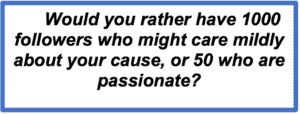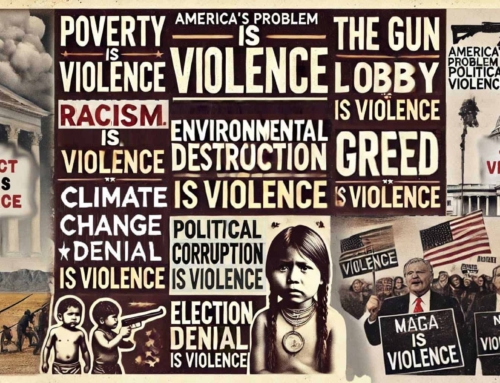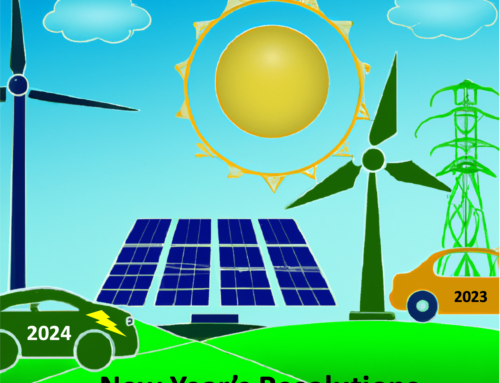Would you show up for a first date with a ring, a proposal for marriage, and your parents in tow? Of course not. But that’s what a lot of climate activists and communication professionals do by mistake.
I was talking to the director of a Minnesota climate organization the other day. He was bemoaning the fact that he couldn’t afford to hire a couple of people critical to achieving his mission. I asked him what he was going to do about it, and he indicated that he was preparing “yet another” fund-raising email to send out to his list of 8000 members.

We want more volunteers, more donors, and more members or friends taking action. So it’s very natural to simply want to add more volume to the top of our funnel. Send more emails or make more calls. The concept of a funnel is used by organizations to measure where people are toward the action we want. The intuitive idea is that the more people, friends, donors or prospects we put in the top of our funnel, the more gravity will allow them to flow out the bottom of the funnel… the more participation we will get; the more donors and so on. It seems to make sense. Except it is entirely wrong!
Regardless of what we want to achieve, the idea that simply putting more in the top of the funnel is hurting our communications. I asked the director I was talking to one question to change his perspective.
 Would you rather have 1000 followers who care mildly about your cause, or 50 who are passionate? (Or similarly, would you rather have 8000 people that may or may not open your email/text or social media asking for money, or 50 that you can count on? Or would you rather have 100 new volunteers for your organization that eventually drop out after a couple of months, or 10 that become passionate contributors?)
Would you rather have 1000 followers who care mildly about your cause, or 50 who are passionate? (Or similarly, would you rather have 8000 people that may or may not open your email/text or social media asking for money, or 50 that you can count on? Or would you rather have 100 new volunteers for your organization that eventually drop out after a couple of months, or 10 that become passionate contributors?)
The idea of flooding the top of the funnel is called scale-jacking. It’s often used to justify the effort. But it’s not efforts that move organizations forward, its actions and results. So the question becomes, how can we get quality results from our communications?
It might be exciting to show up with a proposal for marriage on a first date. It might feel like action. But it is unlikely to get the results your organization really wants. Instead, developing a relationship is often a matter of small steps. So let’s think about how this applies to volunteers, fundraising, and followers. The answer is simple and when you see it, you will think you’ve known this all your life.
It’s to simply turn your funnel upside down. What? Yes, turn your funnel upside down. A concept devloped by Dr. Flint McGlaughlin[i] at MECLABS Institute.

By turning your funnel upside down, you begin to think about what will move people through a series of stages to come out the top. Our task isn’t to find more lukewarm volunteers, it’s to draw, attract and build trust at each step to get people to move to the next stage until they emerge from the top to help with the result we want. It requires us to ask the basic question, what will move people to take the next step. When we don’t do this, those individuals fall out of our funnel.
It’s like the capillary action a trees uses to move life-giving water and nutrients from the ground up into its leaves. Rain can fall on the ground, but if there is no capillary action, the tree will die. More rain from the sky doesn’t help if there is no way to carry the rain to where it is needed.
Let me give a clean energy example. Suppose you want to investigate solar for your residence. A solar energy company ranks number one in its local search. When you see it pop up, it says “We have the best selection of solar equipment in the business.” As you scroll to the second hit, you read, “Learn what our clients say about installing solar.” Which one do you click?
If you are like most people, you click the second. You’re not ready to care about “selection,” you’re not at that stage. But you are curious to see what others say as you begin to do your research. The first Google hit showed up with a proposal for marriage. It was too soon, you didn’t even know you had a need. You drop out of the first company’s funnel and enter the second company’s.
It doesn’t matter if you are a solar energy company or a nonprofit climate organization or just talking to a friend. The concept holds.
- The key to success is changing our mind set from scale-jacking to seduction.
- We must succeed in moving our audience, member, donor or customer to the next step at each step of the process.
- To do this we must answer the question, what is important to them (not us).
Small changes in success of each step are the product of what comes out of the top of your funnel. Let’s do a little simple math. Let’s assume we have 5 steps in our journey, each with an equal impact of a 20% success rate each. That means for every person we get into the first stage they have a 0.16% chance of making it to the top. You need 625 people to enter the funnel!
Now let’s say we figure out a way to double our success at the first stage and second stage, now the number of people we need drops to roughly 156. The math is the product of success at every stage that ultimately determines our result.
So what should we do to change our communication funnel perspective. Here are a few tips.
- Determine how many target or audience interactions we have in order to achieve our goal. This process is called journey mapping. In our example, the first step was a Google search. But it also might be the color of our social media post, or simply answering our phone when someone calls. It might be their reaction to the person answering the phone.
- At each stage ask ourselves what we can do to build trust and move this person to the next step. For example, we don’t say, “come to the climate march” when someone asks us what’s the deal with all the extreme weather at Thanksgiving dinner?
- Put ourselves in the audience, volunteer, donor’s shoes. Without understanding their journey, we are going to show up and throw up with a proposal for marriage. Ask what is important to them at each stage.
- Start to test what works at each stage. It may seem urgent to blast communications, and we may have to do something. But if we don’t learn from each action, then your communications are stuck. Nothing gets better. We want better.
Try this. It may seem a little slower at first but it will give you better results. With each communication, let’s ask ourselves, “Am I proposing marriage, or am I interested in a relationship?”
Thanks for all you do.
We are all connected. Savor the Earth!’™
Hobie,
L. Hobart Stocking
SkyWaterEarth.com
hobart@skywaterearth.com
651-357-0110
Facebook: @SkyWaterEarthConnected
Twitter: @SkyWaterEarth








Leave A Comment